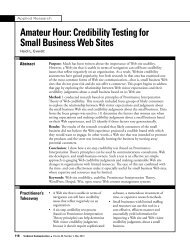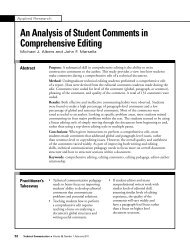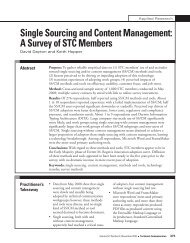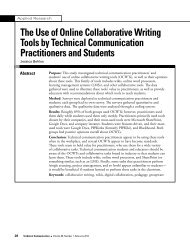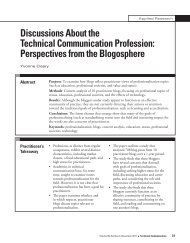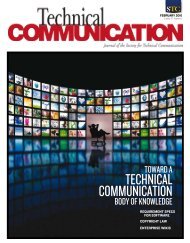When Traditional Chinese Culture Meets a Technical ...
When Traditional Chinese Culture Meets a Technical ...
When Traditional Chinese Culture Meets a Technical ...
You also want an ePaper? Increase the reach of your titles
YUMPU automatically turns print PDFs into web optimized ePapers that Google loves.
Applied ResearchA <strong>Technical</strong> Communication Program in a <strong>Chinese</strong> UniversityIn summary, the surveys, though small in scope,represent a sample of <strong>Chinese</strong> instructors’ and students’views of technical writing in <strong>Chinese</strong> universities. First,students define audience and purpose in terms of thecollective: their motherland. Even when they werediscussing ethics, they seemed to think of ethics interms of the collective: the ethics of society—socialistsociety. Second, technical communication pedagogy—teaching vocabulary and emphasis on memorization—isconditioned by traditional <strong>Chinese</strong> pedagogy, whichfocuses on rote memorization. Finally, technicalcommunication is mainly done by professionals forprofessionals, so teaching technical communicationis teaching professional terms. In short, technicalcommunication in <strong>Chinese</strong> universities is heavilyinfluenced by <strong>Chinese</strong> culture.My TeachingThe interview and survey results helped me designgraduate and undergraduate courses. To myundergraduate students, I introduced the basic formsof technical communication, such as memoranda,instructions, descriptions, short reports, and proposals.In my graduate classes, students learned to manage anextended written project throughout the semester—anoperational manual, a procedure manual, an employeehandbook, a training handbook, or a technical report. Inaddition, students wrote a number of short supportingdocuments such as memoranda, proposals, progressreports, and treatments.In this part of my sabbatical activities, I was both aparticipant and an observer. I was a participant because Iwas the visiting professor teaching 300 students, directlyinteracting with them in class and during conferences ontheir papers. I was an observer because I often observedtheir behaviors, as when they were reading textbooks,course materials, or handouts in order to memorizethem. This part of discussion is based on the data Iobtained as a participant/observer.MethodI wanted to identify the features as conditioned by<strong>Chinese</strong> culture and as manifested in the students,especially in the way they performed academically ina technical communication class. But first I needed todecide where to look for these features. My graduateclass syllabus divided a student’s course grade intofour components: two 2-page papers, one 6-pagepaper, one 15-page paper, and class participation. Formy undergraduate students, the syllabus had similarcomponents of course grade—written work and classparticipation, though the written work consisted of fiveshort papers. I was able to determine the following twoprinciples that governed my research as a participant andan observer:Strategies students used for completing papersStudents’ performance in classMy participatory/observational study took placeduring the entire 16-week semester at ZhengzhouUniversity. There were 300 students in six classes. Itaught each of the six classes for 2 hours a week: twoclasses on Monday, two on Wednesday, and two onThursday. I read a total of 1,560 drafts of papers by bothgraduate and undergraduate students. In addition, Iconducted a 3-hour conference with my students everyday of the week. My participatory/observation researchrevealed the following three features:Large class size is conducive to developing students’sense of collectivism.Memory-based study habits help students learncourse materials and succeed in examinations.A broad thinking style in their papers suggestsstudents’ sense of patriotism.DiscussionStudents’ sense of “collectivism” in large classes.In teaching 300 students in six classes, I met withtwo major challenges: conducting weekly one-on-oneconferences with students, and grading papers. Clearly,it was impossible for me to conduct conferences withall of my 300 students every week or to read and grade300 papers a week. However, it provided an excellentopportunity for me to observe more students than Ihad expected. But still I expressed my concerns to thedean, who told me immediately that I might choose toread and grade a sample of 10 papers from each classfor every assignment. I also suggested that we break thelarge classes into smaller ones, but the dean explainedthat such large classes were arranged on purpose, becausethey were conducive to developing students’ sense ofcollectivism, which was always emphasized in <strong>Chinese</strong>education.44 <strong>Technical</strong> Communication l Volume 58, Number 1, February 2011



